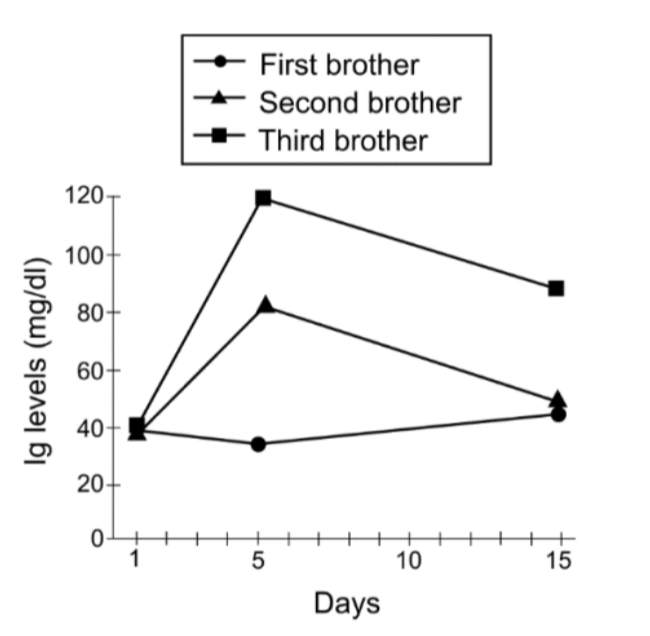Hello, future doctors! A lot of students that I have taught struggle with passages that include experiments, whose results are generally summarized in the form of a graph or figure. I’ve found that by mastering the ability to quickly assess and extract information from graphs and figures has been a surefire way to help increase student’s scores and their confidence in taking the exam. In this post, we will discuss important pointers and focus areas so that you can conquer any of these passages.
The basics
Become familiar with common graph types. As you go through UWorld, practice exams, section banks, try to pay attention to common graph types or figures that you encounter. Generally, the MCAT is quite repetitive (although the content can differ). We will briefly discuss common types, but this list is non-exhaustive.
Tables

Though tables seem to be fairly non-threatening, one can see that they readily share a lot of information all at once. Pay particular attention to comparison. In this example, what differs between each trial? What is going up? What is not changing? What can I conclude? Here, I can say that the length does not seem to increase despite increasing temperature. What can you say about voltage? Ask yourself, what is the rate of change?
Bar Graphs
 One of the most common result figures are bar graphs, especially in the context of mouse or genetic knockout experiments (which are aplenty in biology/biochemistry). Here, try and pay attention again to comparisons you can make. Try to figure out what is being compared. In this context, we’re comparing many things, all at once. We have 3 different comparison groups (Wild Type, a CatB knockout, and a CatB, CatL knockout). On the bottom we’re introducing different genes. And what is the overall outcome? It is the total number of cells infected. So here, we’re trying to understand, how the number of total infected cells differ between these three models. What can you tell me about the baseline (Wild Type)? What can you tell me happens if we knockout CatB? What if we knockout both? How do things change with the various additional genes?
One of the most common result figures are bar graphs, especially in the context of mouse or genetic knockout experiments (which are aplenty in biology/biochemistry). Here, try and pay attention again to comparisons you can make. Try to figure out what is being compared. In this context, we’re comparing many things, all at once. We have 3 different comparison groups (Wild Type, a CatB knockout, and a CatB, CatL knockout). On the bottom we’re introducing different genes. And what is the overall outcome? It is the total number of cells infected. So here, we’re trying to understand, how the number of total infected cells differ between these three models. What can you tell me about the baseline (Wild Type)? What can you tell me happens if we knockout CatB? What if we knockout both? How do things change with the various additional genes?
Line Graphs
 I hope by now you’re picking up a trend… it’s all about comparisons! Line graphs are used to compare different groups across time. Here, we want to focus on how the immunoglobulin levels differ over time for each brother. What can we say about the first and second brothers? I see that though the second brother seems to have an increased Ig level at day 5, by the endpoint, they are the same. The third brother, however, has both a higher level at day 5, and by the end. Also focus on the trend! Both the second and third brothers peak at day 5, then decline…but brother 1 seems to decline first, then slowly rise.
I hope by now you’re picking up a trend… it’s all about comparisons! Line graphs are used to compare different groups across time. Here, we want to focus on how the immunoglobulin levels differ over time for each brother. What can we say about the first and second brothers? I see that though the second brother seems to have an increased Ig level at day 5, by the endpoint, they are the same. The third brother, however, has both a higher level at day 5, and by the end. Also focus on the trend! Both the second and third brothers peak at day 5, then decline…but brother 1 seems to decline first, then slowly rise.
Know your axes: Pay close attention to what each axis means. As stated in point 1, it’s all about comparisons—if you don’t know exactly what comparisons you’re making, you’re likely headed straight to making an error. Before I even look at trends, I look at the title of the figure, and then look at X and Y to see what I’m even comparing. A second point is to also pay attention to the actual relative change on the axes. A line graph can be deceiving and show a huge change, when the actual value only goes from 9 to 10. The MCAT is no stranger to such deception, as part of their testing methodology wants to see how your ability to be detail-oriented and think critically.
Developing interpretation skills
Look for Trends and Patterns
In biology/biochemistry and chemistry/physics, graphs often illustrate trends or relationships as I have mentioned. In particular, do your best to see if things have a direct, inverse, or no correlation. If there’s a direct correlation, is it linear, logarithmic, exponential?
Understand Scales and Units
As I mentioned know your scales (linear, logarithmic, etc.) and units (like mM, kPa, etc.) used in graphs. This knowledge is crucial to making accurate conclusions. This is when it is important to tie it back and contextualize it to the passage. For example, relatively small, linear changes in blood pressure may have important consequences for an experiment, whereas an exponential change in blood flow velocity might not be that meaningful—the meaning of these changes can only be understood when you apply it back to the passage and use the clinical/experimental context!
Critical analysis and application
Relate to Underlying Concepts
I could write an entire blog post solely on tying things back to broad, overarching MCAT concepts. When you look at a graph or figure for the first time, do your best to connect it to the underlying scientific principle or concept. Ask yourself, what are they testing me on? For example, some are easy—if you see a table with initial and final concentrations and a figure where the slope is labeled as “k”, your brain should immediately think “they’re trying to see if I understand kinetics.” Generally, it is not always so straightforward, and a passage may give you just a table or just a figure, and you will have to connect the dots yourself. Another example could be an experimental passage on how blood flow changes with differing length, vessel radius, etc.… one should immediately tie this to Poiseuille’s law! This is something that comes with mastery over all of the scientific principles and concepts that the MCAT loves to test—when studying be actively thinking about big topics when analyzing these results figures. It is easy to become hyper-fixated on the specific example at hand and lose sight of the concept that you’re actually being tested on.
Predicting Outcomes
We discussed previously about how you’re supposed to make comparisons based on what is shown in the figure. One thing the MCAT loves (especially in CARS) is asking you to predict outcomes based on the limited information given, to assess your ability to extrapolate. For example, they might give you a knockout model with three different genes. They will show you the outcomes with each one of the genes knocked out (i.e., 3 different bars). They might then ask, what would the outcome be if 2 of the 3 genes were knocked out. Now you need to apply what you know about the genes knocked out individually (based on the skills mentioned before) and do your best to understand from those findings what would happen if both were knocked out. Again, this skill also comes with practice, and the better your foundational ability is to understand what is in front of you, the better your ability will be to make predictions on hypothetical conditions.
That’s a lot of information all at once, but I cannot stress enough how important this skill is in order to be successful. A lot of students get bogged down by content and knowing specifics, but a lot of the MCAT is about taking in novel information and findings, tying it back to those principles you’ve been drilling, and make meaningful conclusions. Always take note and look for patterns—not just for figures and graphs, but for all parts of the MCAT. Active studying will allow you to develop the heuristics and skillset to take on anything the exam has to throw at you!

Comments